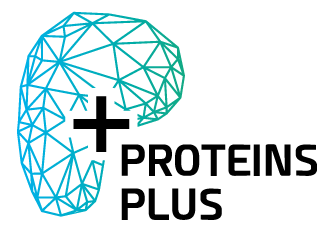About ProteinsPlus
The aim of ProteinsPlus is to support life scientists in working with protein structures 1,2,3. Protein structures are the key for an understanding of function. They are an important resource in many biotechnological application areas from pharmaceutical research to biocatalysis. ProteinsPlus has its focus on protein-ligand interactions. The server provides support for the initial steps when dealing with protein structures, namely structure search, quality assessment, and preprocessing. Furthermore, advanced options, such as protein pocket detection, ensemble generation or prediction of metal coordinations are supported. All tools are developed in the Computational Molecular Design Group (AMD) headed by Matthias Rarey. Currently, ProteinsPlus allows you to:
Measure and visualize electron density support for individual atoms and structural units (EDIA)4
Screening of structures based on selection criteria (StructureProfiler)5
Visualize structures and create 2D pose depictions (PoseView)6
Predict protonation and tautomerization, place hydrogen atoms (Protoss)7,8
Generate SMILES notations for small molecules in PDB files9,10
Predict binding sites and estimate their druggability (DoGSiteScorer)11
Search for alternative binding site models and conformations and generate aligned protein structure ensembles (SIENA)12,13
Classify the interaction type of protein-protein complexes (HyPPI)
Prediction of coordinates of metals in metalloproteins (METALizer)
Placement of water molecules in the active site (WarPP)14
Find structural data of the PDB to activity values stored in the ChEMBL database (ActivityFinder - alpha release)
Textual, numerical, and chemical 3D searching in the PDB (GeoMine)15,16,17
Fully automated protein-ligand docking (JAMDA)18
Search mutations in protein structure databases like the PDB (MicroMiner)
Predict binding sites and estimate their druggability (DoGSite3)19
Visualize interactive 2D ligand interaction diagrams (PoseEdit)20
Calculate solvent channels and their corresponding bottleneck radii (LifeSoaks)21
Several of the underlying tools are components of professional molecular modeling software provided by BioSolveIT GmbH. Some tools are available as part of the NAOMI Chembio Suite for stand-alone use in academic and commercial environments from us.
The development of the ProteinsPlus web service is supported by the BMBF as part of de.NBI – German Network for Bioinformatics Infrastructure. Its use is free for academic and commercial purposes – we thank you for citing the ProteinsPlus and the computational methods behind it. You find the corresponding references below and in the short description of each tool.
ProteinsPlus is a common framework to make computational tools for structure- based molecular design developed in the AMD research group of Prof. Matthias Rarey available on the web. For more information on scientific literature, software availability, and projects we refer to our group homepage and to the web page of our software development partner BioSolveIT. Everybody from the AMD group provided components in use behind ProteinsPlus. The ProteinsPlus web server was originally developed by Rainer Fährrolfes. Many thanks to Ruben Steinegger who developed the keyword search functionality on top of the PDB RESTful service (Bachelor thesis at the Technische Hochschule Mittelhessen (THM)) as well as to Konrad Diedrich and Lennart Weihs for integrating the REST Api for the ProteinsPlus web service.
The ProteinsPlus server and all its attached components are provided as is. Any warranties, including, but not limited to correctness, fitness for a particular purpose, data safety are disclaimed. In no event, the University of Hamburg shall be liable for any direct or indirect damages.
To justify funding for our web services, we are obliged to collect statistical information about their usage. The package Matomo is applied to gather the following user information in an anonymous form:
- anonymised ip address
- web browser and plugins
- operating system
In case you want to use our tools without tracking of any kind, we encourage you to install software components locally. Software licenses are provided free of charge for academic use (for further information see http://software.zbh.uni-hamburg.de).
The server uses the following technology:
- Ruby On Rails: rubyonrails.org
- NGL Viewer: github.com/arose/ngl
- Chart.js: github.com/chartjs/Chart.js
- Moment.js: github.com/moment/moment
- DataTables: datatables.net
- Bootstrap: getbootstrap.com
- DelayedJob: github.com/collectiveidea/delayed_job_active_record
- Paperclip: github.com/thoughtbot/paperclip
- D3: Data-Driven Documents: d3js.org
- Matomo: matomo.org
- The RCSB PDB RESTful Web Service interface: rcsb.org
- jQuery UI Slider Pips: github.com/simeydotme/jQuery-ui-Slider-Pips
- SmilesDrawer: github.com/reymond-group/smilesDrawer
We thank all developers for generously providing this software.
References
ProteinsPlus should be referenced with the URL https://proteins.plus and the following citation:
Results of individual tools should be referenced with the appropriate citation from the following list:
We are happy to receive feedback and comments, please contact us via e-mail at pplus(at)zbh.uni-hamburg.de.
Impressum des ZBH

